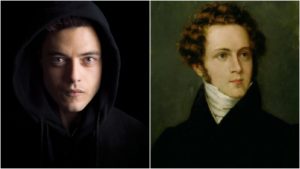
Opera Meets Film: How ‘Mr. Robot’ Uses Bellini’s ‘Casta Diva’ For Emotional Contrast in Season 1, Episode 3
By David Salazar“Opera Meets Film is a feature dedicated to exploring the way that opera has been employed in cinema. We will hone in on a selection or a film in its entirety, highlighting the impact that utilizing the operatic form or sections from an opera can alter our perceptions of a film that we are viewing. This week’s installment features opera in Season 1 of “Mr. Robot.”
This contains SPOILERS.
“Mr. Robot” uses a lot of music throughout its first season. Wide-ranging music to be exact. It gives the world of the film a global feel that matches the heightened stakes of its “saving the world” premise.
And of course, included in that extensive discography are several opera selections; in season one there are two (this isn’t the end of the series’ use of opera, by the way, so stay tuned).
The first of these comes early on in the series at the climax of Episode 3. “Casta Diva” kicks off at the offices of AllSafe before joining that scene with our first introduction to Joanna Wellick, Tyrell Wellick’s wife. The series moves from non-diegetic sound, to diegetic within the household of the couple. It’s actually a jarring transition in many ways, not only being the first operatic extract in the series, but also the shift in audio quality and its immediate association with Wellick, who to this point looks to be the series’ main antagonist.
He finds his wife lying in bed asking to be tied up so they can have sex. Throughout the scene, as Wellick ties her up, they talk about their master plan to knock off the CTO of Evil Corp that will be taking Wellick’s deserved promotion from him. The purity of Bellini’s bel canto line serves as a counterpoint to the situation, its sincere beauty at odds with the transactional interaction between husband and wife, who by the way are expecting a child.
It’s not all that surprising in the context of a show that constantly aims to unsettle its audience with major twists and its ingeniously off-kilter visual style (the frames leave quite a lot of negative space in close-ups, often relegating characters’ heads to the corners of the frame).
But the excerpt doesn’t end there, the initiation of sexual relations timed perfectly with the recapitulation of the aria; the sound mix moves from diegetic to non-diegetic and the music transitions to the Coney Island arcade where Elliot is meeting with fsociety. This is the first time he returns after having rejected the initial call to action of blowing up a storage facility. Throughout the aria’s build to its climax, he enters slowly, the others looking at him as he opens up his computer, sits down, looks around him and says “Here the Plan.” It’s a this point, when Elliot has assumed the leadership of fsociety that the soprano hits her syncopated high A naturals up, the climactic high B flat coming right on the first credit.
If the aria felt completely violated in its use during the Wellick’s Macbeth-like interactions, it feels redemptive, hopeful, and cathartic in this final moment; the timing of the edits is crucial here in delivering that sense of fulfillment and the beauty of the music matches the audience’s own excitement at seeing our hero coming into his own. If you venture to listen to the aria through the credits, the episode’s subtle but heroic ending lingers on through the music.
Later in the season, opera is brought right back into an episode, this time when Tyrell is looking to figure out what is going on with AllSafe’s security. He puts on some headphones and we immediately hear “Der Hölle Rache” blast over the soundtrack. This moment is rather humorous, due mainly to the music’s suddenness in the moment. But it’s a callback to our first operatic introduction and somehow links Tyrell with opera in this first season (though this won’t be a pattern moving forward). It highlights his rage in the moment after having committed murder and emphasizes his own potential for villainy. It’s nowhere near as subtle or engaging as the opening example from “Norma,” but it is the only other instance where opera makes an appearance in “Mr. Robot.”
But, as has been repeatedly mentioned in this article, it isn’t the last.
Categories
Opera Meets Film

